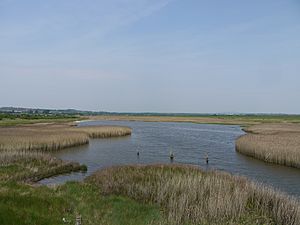Farlington Marshes facts for kids
Quick facts for kids Farlington Marshes |
|
|---|---|
 |
|
| Type | Local Nature Reserve |
| Location | Portsmouth, Hampshire |
| OS grid | SU 685 043 |
| Area | 119.7 hectares (296 acres) |
| Managed by | Hampshire and Isle of Wight Wildlife Trust |
Farlington Marshes is a special place for nature in Portsmouth, Hampshire. It is a Local Nature Reserve covering about 120 hectares (that's like 300 football fields!). This important area is owned by Portsmouth City Council and looked after by the Hampshire and Isle of Wight Wildlife Trust.
The marshes are part of Langstone Harbour, which is a very important area for wildlife. Langstone Harbour is protected as a Site of Special Scientific Interest and a Nature Conservation Review site. It is also part of the Solent Maritime Special Area of Conservation and the Chichester and Langstone Harbours Ramsar site and Special Protection Area. This means it's recognized internationally for its amazing nature.
Contents
What is Farlington Marshes?
Farlington Marshes is an area of land that was created from the sea. It was "reclaimed" from Langstone Harbour way back in 1771. This means people built walls or barriers to push the water back and create new land. A big part of what used to be Binner's Island is now included in the marshes.
Types of Habitats
The marshes are about 120 hectares in size. They have two main types of watery areas:
- Freshwater marsh: This is land that is wet with fresh water, like from rain or rivers.
- Brackish marsh: This is land that has a mix of fresh water and salty sea water. It's a special environment where different kinds of plants and animals can live.
Wildlife at the Marshes
Farlington Marshes is a fantastic place for many animals, especially birds. It's a very important feeding ground for Brent geese. These geese fly all the way from the Arctic to spend the winter here. They come to the marshes to find food and rest before flying back north in the spring. You can often see large flocks of them grazing on the grass.
Other Animals You Might See
Besides the Brent geese, many other birds and animals visit or live at Farlington Marshes. You might spot different types of ducks, wading birds, and even birds of prey. The mix of fresh and brackish water, along with the open spaces, makes it a perfect home for a wide variety of wildlife.
History of the Marshes
Farlington Marshes has an interesting past, not just for nature. During World War 2, it was used as a special decoy site. This was called a "starfish site." Its purpose was to trick enemy planes into bombing the empty marshes instead of important places like Portsea Island. Portsea Island is where the city of Portsmouth is located.
Remaining Structures
Even today, you can still see some parts of this wartime history. The old control blockhouses, which were used to manage the decoy lights and fires, remain on the marshes. They are a reminder of the important role this area played during the war.

